948
Day toilet
1. The first mention of toilet paper dated to the year 589 BC, when Chinese scholar Yan Chzhituy wrote: "I have warned against the use of toilet paper to quotations from the Pentateuch (U-Ching), or with the names of sages." In the IX century, an Arab traveler, who visited China was shocked: "The Chinese did not care about cleanliness - they can not be washed away with water and wiped with paper only," - he wrote.
2. History of the bowl originates in ancient times, some scientists think that even the development of civilization began with his invention. During the archaeological excavations off the coast of Scotland, were discovered toilets whose age is more than 5000 years.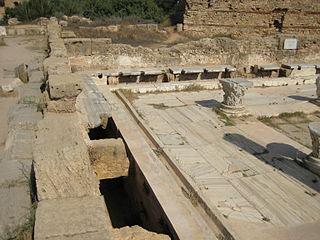
closet, the Baths of Hadrian, Leptis Magna 2nd century NE (Libya)
3. In ancient Rome, public toilets originally appeared at the baths, decorated with marble slabs, and sometimes even painted. Sewage drains merged under the seats, from simply washed away with running water and carried away through pipes in the sewers. The famous Roman drain Cloaca maxima, laid in 500 BC, operates in our vremya.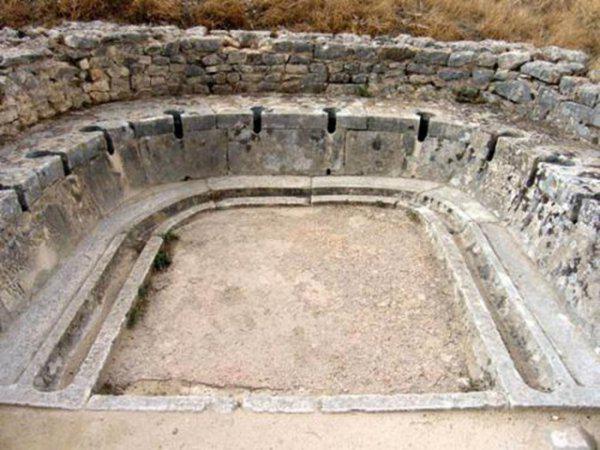
4. It is considered the city of Paris and subtle scents of expensive perfume, imagine how interesting it was to know that in the Middle Ages, it was almost the most dirty and smelly city in the world! Residents easily splashed the contents of chamber pots out the window. And even in the legendary Louvre no toilets. The inhabitants of the palace went to the toilet in the yard! In 1364, a man named Thomas Dyubyusson given the task to draw a bright red crosses in the garden or the corridors of the Louvre, the people there do not gadili. From time to time from the Louvre traveled all his noble tenants Palace washed and ventilated. Leonardo da Vinci was so shocked Paris stench that was designed for Francois First flush toilets. In the scheme of the great Leonardo was and supply water and sewage pipes and ventilation, but ... Leonardo hurried to the creation of the toilet - just a couple of hundred years. Toilets were not postroeny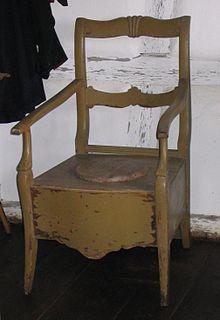
Dressing chair. 19th century Europe.
5. Later in the fortresses were the toilets, built into the walls. Sewage flowed just outside the walls of the city, falling into the moat, heavily polluted water and a source of infection. And also just imagine how such a stink fortress. Top sortirnogo comfort in those days looked like this: a hole with lying next to a handful of straw ...

6. In the same times was popular among the nobility a sort of "portable toilets" - stools with a hole on top and remove the tank from the inside. Mebelshchiki excelled, veiling toilet seats for chairs, stools, desks and even bookshelves! All buildings are usually richly decorated with wood carvings, fabric drapes, gilt.
7. Ancient Russia, unlike Europe, was on his way to the dressing issue. For example, in some villages, the Vologda Region are still using an old custom. In the porch of the hut cut through a window in a barn where the cattle keeping. When the itch, even in winter, the owners are in the passage and use the warm signified window for your needs. And comfortably and efficiently: the waste in the country is a valuable fertilizer, and sometimes fuel. But in the second half of the XVIII century, it was made a revolutionary breakthrough in mechanics. Create great Russian designer Polzunova in 1763 of the steam engine. With this invention, in the towns and estates became introduced an autonomous system of water supply. And there was a large-scale modification of the bathrooms. Began to appear toilets with tank drain, wash basins, equipped with taps, showers, mini-fountains, a swimming pool, Jacuzzi and bidet. It has become fashionable to decorate the toilets, signs familial coats of arms
In general, on the toilet as a work of science and technology and even art can talk endlessly. I might add from myself that in Russia the quality of latrines in the present is far inferior to the European, and this despite the fact that a long time ago it was different.
and a few pictures:


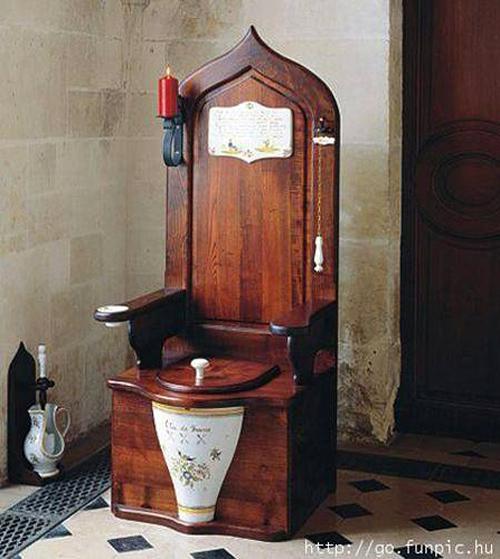
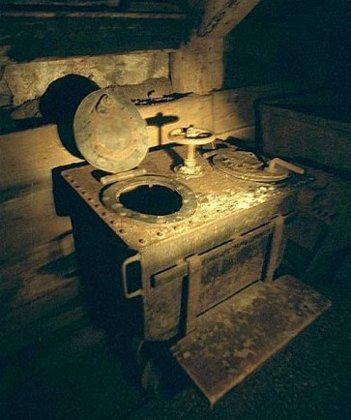


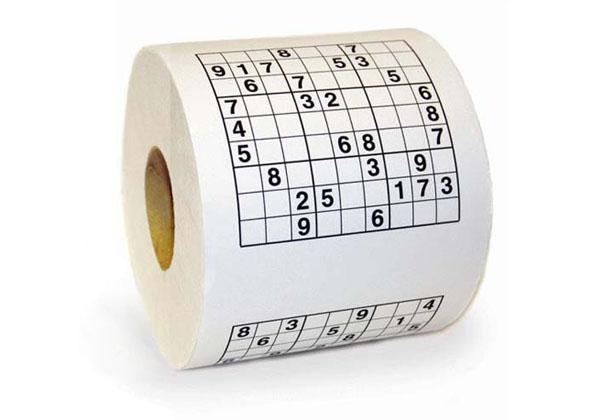
the most expensive toilet is made of platinum and sprinkled brilliantami
2. History of the bowl originates in ancient times, some scientists think that even the development of civilization began with his invention. During the archaeological excavations off the coast of Scotland, were discovered toilets whose age is more than 5000 years.

closet, the Baths of Hadrian, Leptis Magna 2nd century NE (Libya)
3. In ancient Rome, public toilets originally appeared at the baths, decorated with marble slabs, and sometimes even painted. Sewage drains merged under the seats, from simply washed away with running water and carried away through pipes in the sewers. The famous Roman drain Cloaca maxima, laid in 500 BC, operates in our vremya.

4. It is considered the city of Paris and subtle scents of expensive perfume, imagine how interesting it was to know that in the Middle Ages, it was almost the most dirty and smelly city in the world! Residents easily splashed the contents of chamber pots out the window. And even in the legendary Louvre no toilets. The inhabitants of the palace went to the toilet in the yard! In 1364, a man named Thomas Dyubyusson given the task to draw a bright red crosses in the garden or the corridors of the Louvre, the people there do not gadili. From time to time from the Louvre traveled all his noble tenants Palace washed and ventilated. Leonardo da Vinci was so shocked Paris stench that was designed for Francois First flush toilets. In the scheme of the great Leonardo was and supply water and sewage pipes and ventilation, but ... Leonardo hurried to the creation of the toilet - just a couple of hundred years. Toilets were not postroeny

Dressing chair. 19th century Europe.
5. Later in the fortresses were the toilets, built into the walls. Sewage flowed just outside the walls of the city, falling into the moat, heavily polluted water and a source of infection. And also just imagine how such a stink fortress. Top sortirnogo comfort in those days looked like this: a hole with lying next to a handful of straw ...


6. In the same times was popular among the nobility a sort of "portable toilets" - stools with a hole on top and remove the tank from the inside. Mebelshchiki excelled, veiling toilet seats for chairs, stools, desks and even bookshelves! All buildings are usually richly decorated with wood carvings, fabric drapes, gilt.

7. Ancient Russia, unlike Europe, was on his way to the dressing issue. For example, in some villages, the Vologda Region are still using an old custom. In the porch of the hut cut through a window in a barn where the cattle keeping. When the itch, even in winter, the owners are in the passage and use the warm signified window for your needs. And comfortably and efficiently: the waste in the country is a valuable fertilizer, and sometimes fuel. But in the second half of the XVIII century, it was made a revolutionary breakthrough in mechanics. Create great Russian designer Polzunova in 1763 of the steam engine. With this invention, in the towns and estates became introduced an autonomous system of water supply. And there was a large-scale modification of the bathrooms. Began to appear toilets with tank drain, wash basins, equipped with taps, showers, mini-fountains, a swimming pool, Jacuzzi and bidet. It has become fashionable to decorate the toilets, signs familial coats of arms

In general, on the toilet as a work of science and technology and even art can talk endlessly. I might add from myself that in Russia the quality of latrines in the present is far inferior to the European, and this despite the fact that a long time ago it was different.
and a few pictures:







the most expensive toilet is made of platinum and sprinkled brilliantami

Funny translation
Spectacular footage of destruction 17-storey building in Scotland by controlled explosion.























